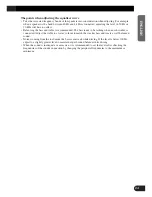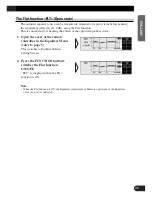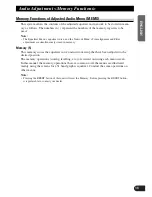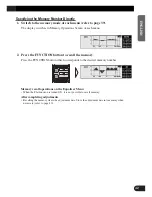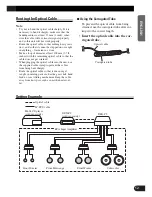
37
Audio Adjustment <Network>
Important points in adjusting the slope
• A decrease in the absolute value of the slope (more gentle inclination) makes the frequency
characteristics more susceptible to interference from the next band.
• Increasing the absolute value of the slope (sharper inclination) lessens the connections between
bands, giving the listener the impression of hearing separate, unrelated sounds.
• Make adjustments while monitoring the link between bands by outputting all the bands as well as
by outputting two neighboring bands only, using the Mute function (refer to page 34).
Important points in adjusting the phase
• When the values of the slope at the crossover point are set at –12 dB/oct. or –36dB/oct. for both
filters, the phase reverses 180˚ in the cut-off frequency of the filter. In this case, setting to reverse
improves the connection between sounds.
For better frequency characteristics
• Adjusting the filter together with the equalizer function (page 22) creates a natural sound environ-
ment in the car.
Adjusting the subwoofer effectively
• Although the slope of the high pass filter is normally set as PASS, H.P.F. may sometimes repro-
duce clear and high quality bass rage. In this case, adjust the cut-off frequency to 20 — 40 Hz and
adjust the slope to –18 — –36 dB/oct.
• If the subwoofer is installed in the rear tray, setting up the slope of the low pass filter gently (–6,
–12 dB/oct.) gives the listener the feeling that the sound dwindles to the rear, with a resultant dis-
tortion of the forward sound image position. It is recommended to set the slope at –18 dB/oct. or
more and set the cut-off frequency to 100 Hz or below.
Adjusting the low-range effectively
• When the subwoofer is connected and low-ranges are reproduced by small speaker unites such as 4
or less than 5-1/4 in. in diameter, setting the low-range H.P.F. as PASS may increase the distortion
when strong bass signals enter. Should this occur, set up H.P.F. to avoid interference with the sub-
woofer.
Adjusting the high-range effectively
• Depending on the speaker units installed, bass signals for the tweeter (about 2 kHz or below) may
cause distortion as the high pass filter is being adjusted. If this happens, set a sharp slope of –18 —
–36 dB/oct. In this case, choose such settings that the mid-range and tweeter do not become sepa-
rated.
• The low pass filter is generally set to PASS. However, if the ultratreble band falls harshly on the
ear, it is possible to set up a more gentle slope of about –6 dB/oct.
0 dB
–3 dB
Normal
Reverse
–12 dB/oct.
–36 dB/oct.


